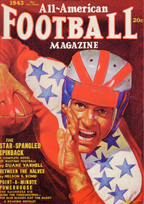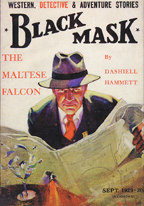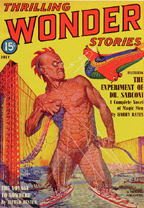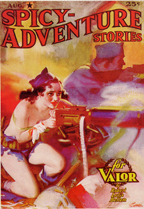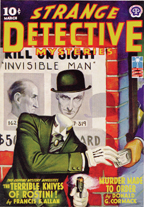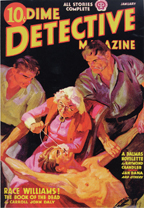Comics /
Cult Favorite
Pulp Culture, Part 2: An Overview
By Philip Schweier
July 15, 2006 - 11:28
In the age before mass-market paperbacks, there were such things as dime novels, so called because that’s about how much they cost. Cowboys were the usual fare, the aim of the magazine to entertain young boys. On magazine racks across America, real life Western heroes such as Wyatt Earp stood side-by-side with manufactured ones such as Hopalong Cassidy.
New genres such as detective mysteries and science fiction followed. The variety of material tapped into wider audiences, and gave birth to stories to suit every taste. The earliest of these was
Argosy, which debuted in October, 1896. While rarely considered literature in the classic sense, these pulp magazines fed the general public a steady diet of thrills, danger, romance and wonder.
As competition increased, covers became increasingly colorful and often lurid, in the hopes of catching the eye of the casual passerby. In between the covers were anywhere from 114-162 pages of stories. A lead novel ran 50,000-60,000 words, with five or six supporting short stories about 20,000 words each.
Competition was stiff, with newsstands filled with magazines dedicated to mystery, adventure and science fiction. Classic characters such as Dashiell Hammett’s Sam Spade and Zorro by Johnston McCulley have become part of the pop culture landscape.
For some authors, the pulps were a stepping stone to greatness, allowing them to hone their craft before a book publisher came looking for a novel. Edgar Rice Burroughs, Ray Bradbury and Zane Grey all got their starts in the pages of monthly magazines such as
All-Story and
Black Mask.
The writers were prolific, generating ideas borne of science and nature, as well as the headlines of the day. An advanced design for an airplane from
Popular Mechanics might play a role as a futuristic airship in the pages of
Tales of Wonder. A notorious crime boss may be used as the model for a villain in
True Detective.
The pay for writers was meager, usually a penny a word, sometimes more after one had proven oneself. Frederic Faust, who wrote Westerns under the pseudonym Max Brand, was known as the King of the Pulps, earning a whopping 5-10¢ a word.
More industrious writers were known to submit numerous stories under a variety of pen names, sometimes resulting in an entire issue being written by a single person. Churning out story after story often prevented the luxury of multiple drafts, with better writers getting it right – or nearly so – the first time around.
The action was fast paced, much like the Saturday afternoon serials of the day. Villains narrowly escaped capture, and the heroine was often nearly but not quite rescued by the hero, ensuring further chapters in the thrilling adventure. Entertainment was the watchword. Readers young and old looked forward to reading while eating their breakfast, or riding the commuter train to work.
The covers were often gaudily painted portrayals of the hero facing some peril, the weirder the better. Mirrored images, strange creatures, and fantastic settings promised adventures the likes of which seldom seen. Scantily clad women appealed to boys on the
cusp of adolescence, as well as older readers looking for cheap thrills.
Many a journeyman artist cut their teeth doing covers for
Western Roundup or
Amazing Stories. Among the most popular were Raphael De Soto, J. Allen St. John, H.J. Ward, and Rudolph Belarski. Today, their pulp cover paintings are in high-demand, and are valuable pieces of Americana.
Originals of the covers can be extremely rare. Only several hundred are known to exist, despite more than 50,000-60,000 pulps being published. Once a cover painting was published, the canvas was often reused by the artist or destroyed by the publisher.
There were a variety of genres from which to choose. Not only were there Western stories for boys, and romance tales aimed at girls, publishers even went so far as combine subject matter, leading to such titles as
Rangeland Romance and
Spicy Detective Stories. Horror and mystery blended to form
Strange Detective Mysteries, and romance and war were matched up as
Spicy Adventure Stories.
With the advent of World War II, paper shortages began driving many of the struggling pulps publishers out of business, while the burgeoning comic book market attracted younger readers. Fewer pages enabled comic book companies to significantly undersell pulps. At war’s end, the few remaining pulp publishers were those who had been able to diversify their magazine line.
With the postwar boom, the priorities of America began to change. Many young men who had comprised the bulk of the pulp audience during the 1930s had enlisted in the service. Those fortunate enough to return home from the war looked forward to building a new way of life for themselves and their loved ones. For many, the sanitized thrills depicted in the pulps were nothing like the true dangers of the battlefield.
Nevertheless, longtime pulps continued to fight for their share of the market. Wartime paper shortages reduced even the most popular titles such as
Doc Savage and
The Shadow – the latter published twice a month for more than 10 years – to digest size. Following the end of the war both were reduced to quarterly publication before being canceled in the summer of 1949.
Better authors would survive the transition from magazine to book formats. Others, such as Leigh Brackett and Alfred Bester, would find work writing for film or radio, or find positions as editors for publishing firms or other magazines. The characters themselves would serve as a foundation for heroes in the comics, if not being resurrected themselves.
Today, it is estimated that less than 1% of the original pulps remain, making them highly sought collectibles. Some of the more popular properties, such as The Spider and G-8 and His Battle Aces, have been republished in paperback form. Other stories can often be found in collections available from companies such as Bud Plant or on various Internet websites.
While many pulp fiction stories are be regarded as mindless entertainment for the masses, there are a number of diamonds in the rough that have been polished and refined to gemlike quality. Many have been turned into highly acclaimed films and novels. One such story is Harry Bates’
Farewell to the Master, originally published in Astounding Stories, which was later released as the cerebral science fiction film
The Day the Earth Stood Still.
Maybe the pulp style of fiction is out of date, and I’ll be the first to admit that many of the stories can be ridiculously corny, with dialogue straight out the matinee serials, another story unto themselves. Great literature doesn’t always have a deeper meaning. Sometimes it is simply a tale well told by the likes of Louis Lamour or Raymond Chandler. If you want sheer fly-by-the-seat-of-your-pants action and adventure, pulps have a lot to offer. •
NEXT WEEK: The pulps and the advent of comic books
Praise and adulation? Scorn and ridicule? E-mail me at pschweier@hotmail.com
Last Updated: March 3, 2025 - 20:40
